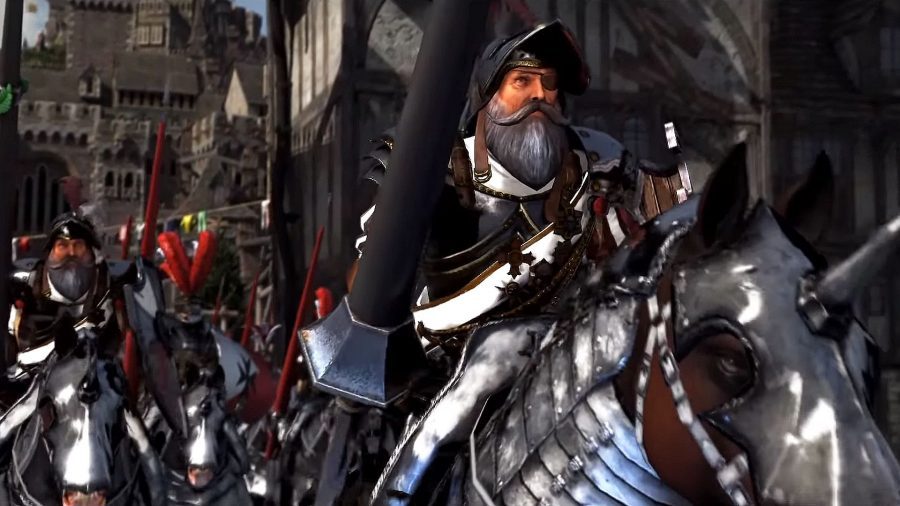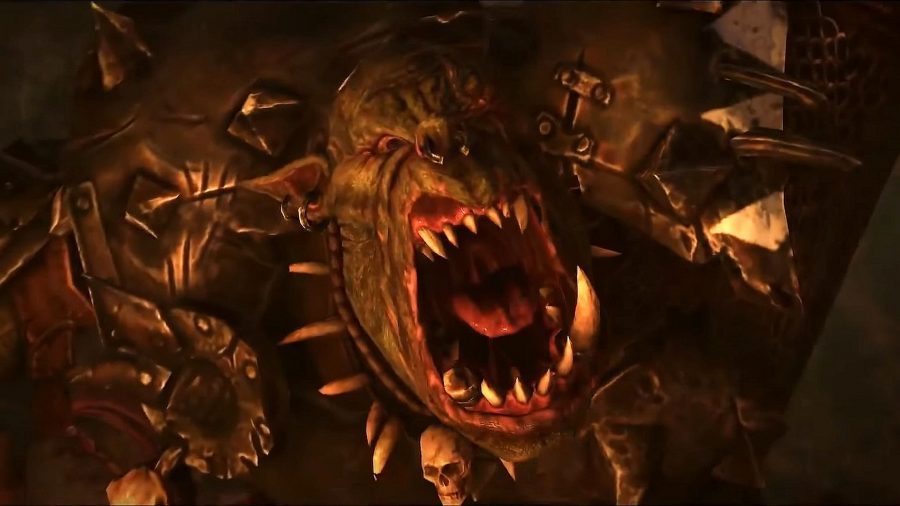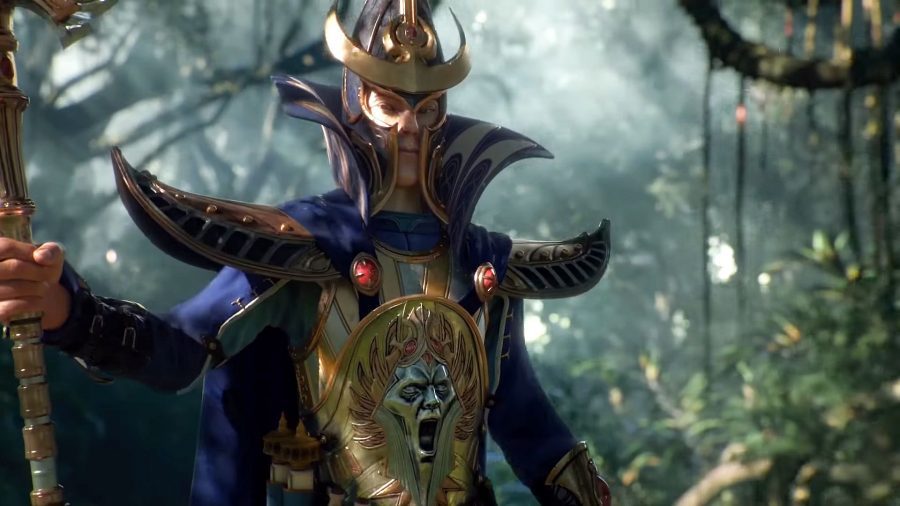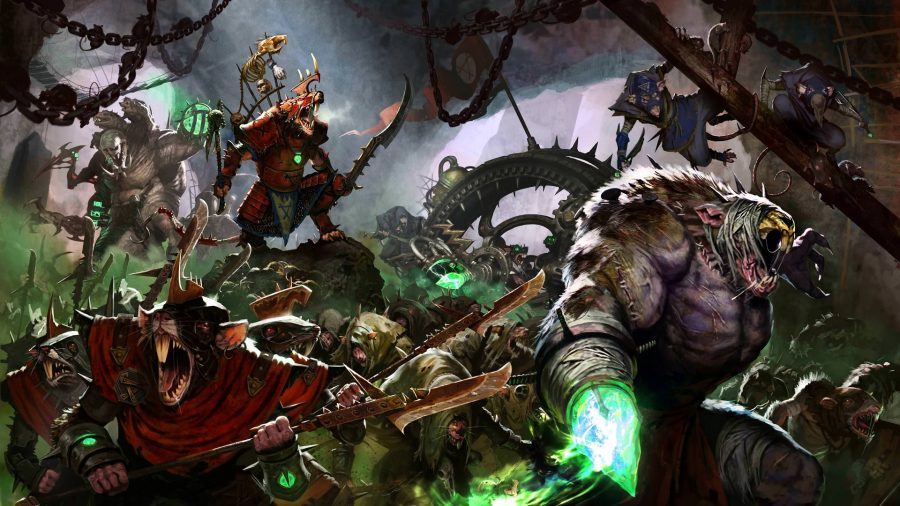It’s official – Warhammer: The Old World is coming. Like probably too many players of Warhammer Fantasy Battle (WFB), I rehearsed the five stages of grief with my friends via text in 2015, as Games Workshop’s plan to kill a game we’d played together since 1998, and replace it with Age of Sigmar, unfolded.
But just as I’d reached acceptance and made peace with WFB’s demise, GW announced its resurrection, the cheeky snotlings, in the form of Warhammer: The Old World. GW has been drip-feeding us some really exciting details ever since, but there’s still quite a lot we don’t know about it. If, in your ecstatic delirium, you’ve assumed that we’re getting WFB: Ninth Edition – well, that may be premature.
To help shed some light on all this, we thought we’d walk you through the knowns and the unknowns. Citing every official post from GW yet released about The Old World, we’ll cover the setting (temporal and physical) and all the races that have been mentioned so far, as well as the really important questions that still need answering.
But whatever else Warhammer: The Old World is, we can take solace in this: it’s definitely a tabletop game set in the original Warhammer Fantasy world. And it’s bringing back square bases.
Warhammer: The Old World release date
Warhammer: The Old World was announced on November 15, 2019, and GW was at pains to make clear that “this is a long way off. Years. More than two. Like three or more. Definitely not soon.” This means we’re talking no sooner than 2022, and very possibly 2023.
Indeed, in a Warhammer Community update article on The Old World on July 21, GW reiterated, with deliberate titillating coyness, that it would still be “quite some time yet” before the game arrived, and that further updates would arrive on the Warhammer Community site “at some point”.
Warhammer: The Old World MAP, setting and timeline
The new game is subtitled ‘The Old World’, which is also the name of Warhammer’s analogue of Europe. It’s a particular continent on the wider world of Warhammer Fantasy, which is now referred to as “the world-that-was”.
Signs suggest The Old World will focus on its titular continent
While GW does talk about returning to the world-that-was more broadly in certain contexts, none of the maps in its posts about The Old World range beyond Kislev or the Badlands, nor do they mention places or people beyond those borders. At risk of stating the obvious, this suggests The Old World’s initial release will focus on its titular continent and the inhabitants thereof, as opposed to further-flung races. As far as the timeline is concerned, GW has confirmed that Louen Orc-Slayer (not Louen Leoncouer) is King of Bretonnia. Bretonnia’s last army book states that he declared an Errantry War against the Orcs in 2201IC, so that gives us a ballpark year.
However, as a Bretonnian King, Louen would’ve drunk from the Grail, extending his life and meaning his reign could’ve lasted for many decades, so there’s a lot of ‘play’ around this date.
Warhammer: The Old World races confirmed
Grand Cathay: Almost Confirmed
Heavily based on the culture, aesthetics, art, and warfare of Imperial China, Grand Cathay sits on the far eastern edge of the Old World, bordering the Ogre Kingdoms and Eastern Steppes beyond. Given fleeting mentions in WHFB – but cropping up as early as the game’s second edition – the huge human empire remained something of a mystery that never even received an official army book.
That looks to change with Warhammer: The Old World. Alongside a Total War: Warhammer 3 trailer revealing Cathay’s forces in action for the first time, Games Workshop confirmed it had created tabletop rules for every Cathay unit to be translated into the videogame. The Warhammer Studio reportedly established “each and every unit for use on the tabletop, including stats and special abilities”, to work with Warhammer Fantasy Battle’s eighth edition rules. That means there’s a GW-authored WHFB Cathay army ruleset floating around, just ready and waiting.
New Model Armies: Our guide to Age of Sigmar factions
Although Games Workshop didn’t explicitly confirm Grand Cathay will appear in Warhammer: The Old World, given a full tabletop ruleset has been created for the army and the released Cathay concept art features the Old World logo, it’s not much of a stretch to suppose this iteration of Grand Cathay will be appearing on our tabletops in the WHFB revival.
And we’ve got plenty of hints as to what that will look like. The army’s Total War: Warhammer 3 reveal trailer is replete with serried ranks of halberdiers, mages, war machines, cavalry, hot air balloon battleships, hand cannoneers, and dragons. Games Workshop has explicitly named the Alchemist and Astromancer spellcaster units, as well as the terrifying Terracotta Sentinels. There’s a lot going on with this army.
Cathay was one of the largest human factions of the Old World. Technologically advanced and culturally replete, the Mountains of Mourn cut off the empire from other human nations. Not that it required much aid. Cathay follows the god-like Celestial Dragon Emperor and his wife, the Moon Empress, who match the power of the Chaos Gods. Capable of transforming into human form, their children – Miao Ying and Zhao Ming – govern the empire and will be popping up in Warhammer: Total War 3. An indication they’ll also be coming to Old World? Perhaps.
Kislev: confirmed
Defined by its ceaseless struggle against the evil powers of Chaos that lie to its north, Kislev is an impoverished but battle-hardened land of rugged humans, some of whom ride bears into battle. Aesthetically it’s inspired by Slavic nations, particularly Russia, and it never got a fully fledged army book in Warhammer’s previous editions – merely a threadbare supplement in 2003.
So it was a bit of a surprise when the very first post about Warhammer: The Old World after its announcement was all about this harsh, icy realm, and even more so when it was followed by another article on its new bear cavalry.
Old World and new: The best Warhammer fantasy videogames
And, in the July 21 update, we got the further titbit that, at the time Warhammer: The Old World is set (confirmed to be “several hundred years” before the Old World’s apocalyptic End Times) Kislev’s borders extend far further than has been documented in previous Warhammer fantasy outings. How this will apply to the faction in the new game, and/or its altercations with the ravening hordes of chaos – surprise, surprise – we don’t know yet.
GW says that “one of the coolest aspects of returning to the world-that-was is the opportunity to revisit certain aspects of its classic lore and delve into them in greater detail than ever before,” and names Kislev as a “perfect candidate for further investigation,” so it seems clear that we can expect them to be a prominent faction in the new game.
It’s worth pointing out that we don’t fully know what this means yet, though the days when a new army meant a relatively rapid rollout of dozens of models with a single book are probably gone, replaced by GW’s current model of more modular releases. With that in mind, the first Kislev post teases updated models for two classic units (the Ungol Horse Archers and Winged Lancers), and to announce a brand new unit in development: the Ice Guard. Plus the bears, of course.
The Empire: confirmed
Speaking of a “more modular” release model, the Empire – WFB’s foremost human nation – is looking pretty modular in the Old World too. The project’s third tease focuses on its cartography, and shows four separate coats of arms popping up over different regions of the Empire. This is further evidence that Warhammer: The Old World will be set in the Age of Three Emperors, hundreds of years before WFB’s eighth edition or the End Times.
The Empire has a penchant for gunpowder, metal and moustaches
This means we might see multiple Empire sub-factions themed around particular provinces, Elector Counts, or claimants to the throne, similarly to the different Space Marine chapters you can play in modern 40K (obviously it also means you can forget eighth edition special characters like Emperor Karl Franz).
Inspired by the Holy Roman Empire, the Empire is humanity’s mightiest nation – a sprawling Germanic-accented realm with a penchant for metal, gunpowder, and flamboyant moustaches. They had one of the largest and most flexible rosters of any Warhammer army, and as a salty Bretonnia player I could only look on in bemused envy as GW invented every wonderful steampunk toy from mechanical horses to sun-powered lasers to hand them (reader’s note: the loss of authorial distance only gets worse from here).
Bretonnia: confirmed
If your soul beats to the thunder of a stampeding cavalry charge, or you prefer your wargaming with a high medieval, rather than early modern feel, Bretonnia is for you. Putting a badass grimdark spin on Arthurian myth and the timeless aesthetic of French and British knighthood, they’ve been criticised as Warhammer’s least creative faction, to which I say: they’re also its most accessible and romantic. Everyone gets Bretonnia. (I would add that the entire setting began as a Tolkien rip-off, so let’s not pull too hard on the creativity thread.)
Bretonnia was the focus of the Old World’s fifth tease, and shows every sign of being an important fixture in the game. The fact that Louen Orc-Slayer is king hints not only at the date, but also Bretonnia’s current challenges: the nation’s Greenskin infestation was so bad under his reign that he declared an Errantry War to purge it, and it seems that The Old World will indeed see Bretonnia right in the thick of this conflict.
Boogie Knights: These are the best medieval games
Elsewhere, the realm’s 14 dukedoms look familiar from eighth edition, though the names and arms of its current dukes (such as King Louen’s) are all new. Bretonnia got an overhaul in Total War: Warhammer, which added all-new troop types, such as Foot Squires, Grail Guardians, and Royal Hippogryph Knights.
We know GW collaborates on these videogames and approves their content, so there’s every chance some of these troops may appear in the Old World. Whatever form Bretonnia’s new release takes, I and every other fan will be thrilled; we last got an army book in the Year of our Lady 2004. Two thousand and chuffing four.
Greenskins: confirmed
Warhammer has taken Tolkien’s orcs and made them its own, giving them green skin and an injection of chaotic energy that’s almost endearing if you can look past their innate lust for violence and cruelty.
Comprising brutal orcs and cunning goblins, as well as the kitbashed and crude war machines built by the latter, Warhammer’s Greenskins are one of its world’s most iconic natural forces.
Their unsurprising but welcome return in the Old World was confirmed in GW’s Bretonnia post, which highlighted the Orcs of the Pale Sisters mountains near Couronne in particular.
And, in GW’s July 21 Old World update article, it went further, to answer the biggest question on everyone’s minds: Orcs in Warhammer: The Old World will, indeed, be called Orcs – not Orruks, as they are styled in Warhammer: Age of Sigmar.
High Elves: confirmed
Warhammer’s elves are a haughty, long-lived race who live on a magical island built specifically for them by the gods who made the world, much to the annoyance of the Lizardmen, those gods’ jilted first creations.
Being the favourite spawn of an ontologically gifted entity is an apt allegory for the High Elves’ relationship with GW’s game designers, who lavish similar favours on them as those they gift the Empire: the High Elves have another massive and flexible army list, featuring toys that are essential to any fantasy game (dragons), ones which are cool but hey maybe give someone else a turn (phoenixes), and ones which are simply needless indulgence (the absurd Lothern Skycutter).
Perfect pigments: Our pick of the best paints for miniatures
That’s in addition to some of the best wizards, magic items, cavalry, and elite infantry in the game, as well as an army-wide special rule that says they always get to strike first in close combat, because did you see the opening battle in The Lord of the Rings?
Lore fans will know that, during the High Elves’ expansionist heyday, they set up colonies all over the world, and that many Bretonnian cities were built upon their abandoned ruins. Accordingly, the Bretonnia post explicitly mentions four “High Elf enclaves” set along the fair kingdom’s coast, so their presence in the Old World – in some form – seems confirmed.
Wood Elves: confirmed
“All that and we didn’t even mention the Wood Elves!” This is all GW has to say explicitly about the elves’ environmentalist branch (heh), but hey, it’s a mention, and, as all Asrai fans know, if Bretonnia is on the map, then so is the Wood Elves’ forest of Athel Loren.
Borrowing heavily from Tolkien, Warhammer’s Wood Elves are sneaky and agile. They get some of the game’s best archers, as well as badass living trees in a range of sizes.
Warhammer: The Old World unannounced races
Both WFB and Total War will have taught you that Warhammer Fantasy has many other races besides those confirmed above. GW surely isn’t finished drip-feeding us news about the Old World, and I’d expect several of these races to be announced before launch.
For one, the perfidious ratmen known as the Skaven remain popular (to my personal surprise), and by their nature can exist anywhere, burrowing under civilisations the world over.
Boxed beginnings: Which Age of Sigmar starter set is best?
The territory of the Vampire Counts is fully within the borders of the Old World, and, given the importance of the undead to the setting, and the vampires’ Machiavellian involvement in so much of the Empire’s history, I don’t think the game would feel complete without them.
One could say the same (minus Machiavelli) about the Dwarfs. I’d also expect the servants of Chaos to appear in some form – they are by nature ubiquitous, and the definitive foes not only of Kislev and the Empire, but of Warhammer itself.
What of the races beyond the Old World? Again, there’s been no mention so far of Naggaroth or the Dark Elves, of Lustria or the Lizardmen, or of Khemri or the Tomb Kings. I’m sure they’ll happen eventually – even if I’m right and the new game does focus initially on its titular continent, supplemental releases from the wider world-that-was certainly seem like the logical next step.
That’s especially true given that GW has just done a ton of conceptual work on Cathay in collaboration with Creative Assembly, providing perfect material for what could be the first all-new core Warhammer race since the Ogre Kingdoms in 2005 (see also: our musings on Total War: Warhammer 3’s implications for the Old World).
WARHAMMER: THE OLD WORLD RULES

Will Warhammer: The Old World have square bases?
Yes. This was strongly hinted on the Age of Sigmar Facebook page when the Old World was announced. Soon after that, the Warhammer Community team created a bunch of memes so players could celebrate the news, two of which clearly imply that square bases will be supported in the Old World.
GW has now confirmed – after strongly suggesting as much from the reboot’s initial annoucement – that Warhammer: The Old World will use square bases, not round ones.
In its July 21 Warhammer Community article, GW affirmed that “Regiments move in ranked-up units, and strategic manoeuvring into position to launch or receive a critical charge will be as much a key part of the game as it ever was”.
If you’re wondering why square bases and ranked-up units matter, I’m guessing you didn’t play WFB. Models in that game had square (or rectangular) bases, which meant they could tesselate to form neat ranks and files, or fit on rectangular movement trays. Such trays were essential, as it was common to see regiments of 30, 40, 50 or more models in WFB, replete with deliciously complicated rules about facings, reforming, wheeling, and so on. Age of Sigmar eschewed all that – its games are ‘skirmishes’ rather than battles, played out between loosely corralled models on 40K-style circular bases who only have to be an inch apart to count as a squad.
Hence GW’s clear-cut declaration in the July 21 article: “Warhammer: The Old World is a reinvention of the classic rank-and-file game of Warhammer Fantasy Battles”. No messing about there.
From the off, the probability of square bases was the biggest hint we had about how Warhammer: The Old World would actually play. Another way of putting that is to say we still know almost nothing, but a likely corollary from square bases was always going to be ranked units with facings, like the good old days of WFB. And the corollary from that is bigger battles than Age of Sigmar, with hundreds rather than dozens of models.
None of this should be a huge shock, as GW had already been pitching The Old World as a reboot of WFB, targeting WFB veterans (and the newly intrigued Total War audience). But, given the success of its skirmish-scale games, it’s perhaps understandable if WFB veterans are drinking down every drop of encouragement they can find until the rulebook is actually in their hands.
Warhammer: The Old World miniature scale
GW confirmed, once and for all, in its July 21 article, that Warhammer: The Old World will use the same 28mm scale miniatures it had before – putting paid to scurrilous rumours it might go either bigger or smaller.
“We want people to be able to use their old armies if they wish, or to start new ones, or to add new miniatures to old armies – whatever they want”, the article explains.
Speculation had for some time been rife that The Old World would strike out alone with a totally different model scale. Spikey Bits cited “an industry insider” who says they may go smaller (15mm or 8mm), to create battles with a more ‘epic’ feel.
The Old World’s model scale is still unconfirmed
There had been some interesting arguments for this, to do with the precedent set by Warmaster (a short-lived ‘epic’ scale version of WFB), appealing to the Total War crowd, and GW’s recurring problems with models produced by rival manufacturers (as long as GW can’t copyright ‘a knight’ or ‘a size’, there’s presumably nothing stopping those rivals simply producing models at the Old World’s new scale, but it would at least press hard reset on their existing products).
Given the splendour of GW’s current models and the level of detail shown in the concept art for the new ones, I’d be a little surprised if they went in this direction, as well as disappointed – if I can’t use my existing collection, I probably won’t bother. But then maybe GW calculates that the potential new audience ready to buy whole armies is more profitable than the lapsed WFB audience who are simply keen to dip back in with a few new purchases? It’s a calculation that makes some sense, but we’re merely speculating – the Old World’s model scale is still unconfirmed.
Source: Wargamer














